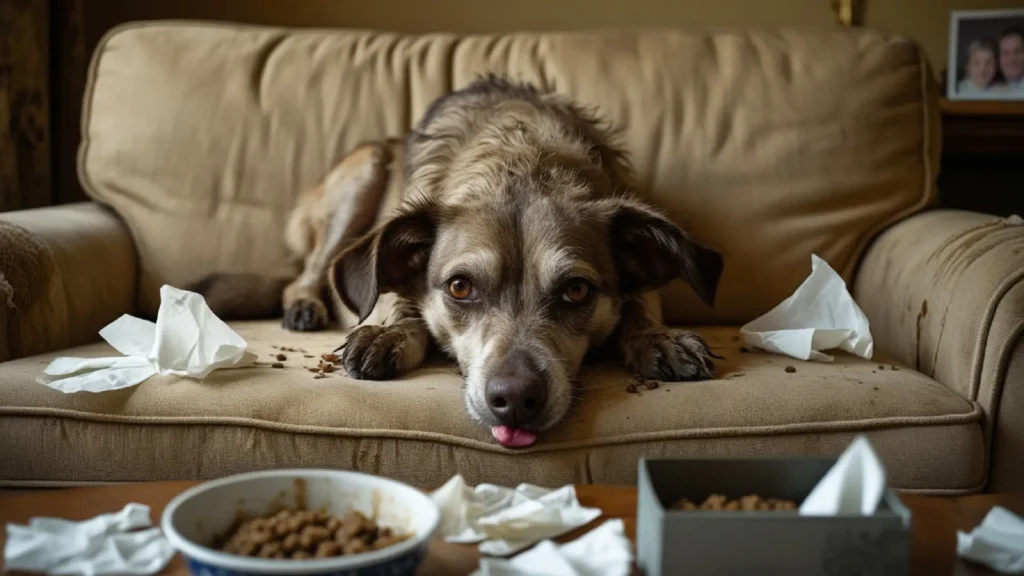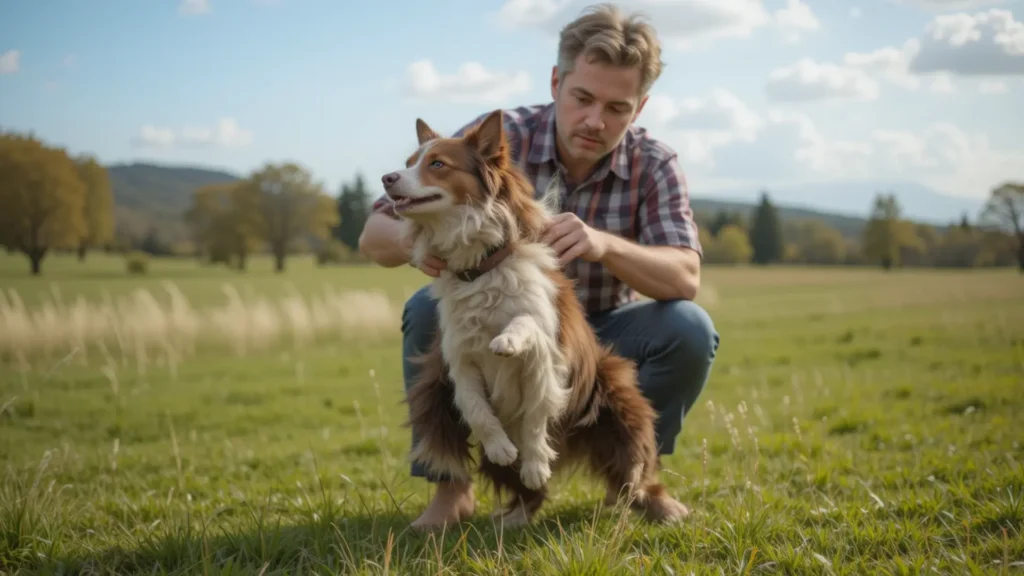Just like humans, dogs are susceptible to various health issues. Many of these conditions are preventable. It is our responsibility to take the right care, attention, and routine veterinary visits.
Understanding common health problems and the right prevention methods help you take proactive steps in safeguarding dog’s health. This guide outlines 10 common health issues dogs face, along with practical prevention tips to keep your dogs in their best shape.
1. Obesity

Obesity in dogs is noticeable through their –
- increased weight
- difficulty moving around, and
- decreased energy levels.
Dogs that are overweight also breathe more heavily, and their joints show signs of wear, leading to discomfort or pain during movement.
Prevalence of Canine Obesity in Different Countries
Country/Place | Prevalence (%) |
United Kingdom | 21.40% |
Australia | 7.60% |
California, United States | 14.80% |
Spain | 66.10% |
Thailand | 42.94% |
Japan | 39.80% |
European Countries | 31.30% |
These factors contribute to the obesity of dogs–
- orthopedic diseases
- type of diet
- change of lifestyle
- neuter status
- breed/genetic background
- socioeconomic status of the owner.
How to prevent Canine Obesity
Portion Control: Follow the recommended serving sizes on dog food packaging or get advice from your vet to determine how much food your dog needs based on their size, breed, and activity level. Avoid feeding table scraps or excessive treats.
Regular Exercise: Ensure your dog engages in physical activity suited to their age and breed. For dogs, this could include daily walks, playing fetch, or runs, while for cats, providing interactive toys or climbing structures can help them stay active.
According to Main Street Veterinary Clinic, “Physical activity significantly impacts your dog’s health, from running, playing fetch, and chasing toys to exploring new places and learning new tricks. Regular exercise gives your dog physical satisfaction, keeps them at a healthy weight, and helps improve their mental health and reduce stress.”
According to a research by Anne D Vitger and Bente M Stallknecht, exercise helps to lose 13.9% of weight among the overweight dogs.
Monitor Weight: Weigh your dog regularly to check their weight and consult your vet if there are any concerns. Regular checkups can help you monitor their weight and make necessary adjustments to their diet and exercise routine.
2. Dental Disease

Dental problems are common in dogs, especially in older animals. Symptoms can include
- foul-smelling breath
- yellow or brown plaque buildup on the teeth
- gum redness
- swelling, and
- difficulty chewing.
Some dogs also show signs of discomfort when eating or even drool excessively. AKC Canine Health Foundation says that, “Canine dental disease starts with un-removed plaque, a pale yellow film formed by bacteria adhering to tooth surfaces.”
How to Prevent Dental Disease of Dogs
Brushing Teeth: Brush your dogs teeth regularly using a toothbrush and toothpaste specifically designed for animals. Start slowly and make it a positive experience to get your dog accustomed to the process.
Chews and Toys: Providing dental chews, toys, and treats designed to help clean teeth can also aid in reducing plaque buildup. These can help keep your dog’s mouth cleaner between professional cleanings.
According to Cornell Richard P. Riney Canine Health Center, in addition to brushing — or if brushing isn’t possible — there are other options to help reduce plaque and tartar, including:
- Dental diets
- Dental chews and treats
- Water additives, oral gels and sprays
Professional Cleanings: Regular dental checkups are essential, as your vet may recommend professional cleanings to remove plaque and tartar that you can’t manage at home. Regular cleanings can prevent more serious issues like periodontal disease or tooth loss.
3. Parasites
Fleas, ticks, and worms are common parasites that can cause a range of symptoms in dogs.
- Fleas cause itching, hair loss, and visible flea dirt on your dog’s skin.
- Ticks cause redness or swelling around the bite area, and some ticks can carry diseases.
- Worms, such as roundworms, tapeworms, and heartworms, can cause vomiting, diarrhea, weight loss, or lethargy.
Health for Animals says that, “Parasites like fleas, ticks, mites and worms are a lifelong risk for dogs. They cause pain, discomfort, and disease that can be life-threatening for a dog if left untreated.”
How to prevent parasites
Preventative Treatments: Use veterinarian-approved flea, tick, and worm preventatives. These can be in the form of spot-on treatments, oral medications, or collars. Be sure to follow the directions carefully, as dosing varies depending on your dog’s weight and size.
According to Woodgreen dogs Charity, “Fleas are highly irritating and uncomfortable for dogs. To avoid getting an infestation you should use preventative flea treatment every 4-8 weeks. It’s important to use a veterinary product as these are much more powerful and effective than products sold in supermarkets.”
Regular Checks: After outdoor activities, particularly in wooded or grassy areas, check your dog’s fur for ticks. If you find a tick, remove it carefully using proper techniques or consult your vet.
Environmental Control: Treat your home and yard for pests regularly to prevent reinfestation. Wash your dog’s bedding often, and vacuum frequently to remove fleas and eggs from cardogs and furniture.
American kennel Club suggests, “Don’t just check your dog for fleas and ticks—treat their environment, including your home, as well. In fact, homes are desirable flea habitats because the fleas are shielded from the outside elements.”
4. Arthritis

Arthritis in dogs is common and manifests as joint pain and inflammation. Dogs with arthritis may
- Limp
- favor one leg
- have trouble jumping
- climbing stairs
- moving quickly.
- Yelping when Touched
- Changing Behavior
- Muscle Atrophy
Stiffness, especially after rest, is another common sign. According to Blue Cross, “Arthritis can be the result of –
- an injury such as ligament damage or broken bones
- hip dysplasia and elbow dysplasia, which is a genetic condition common in labradors and German shepherds
- certain breeds, such as labradors, retrievers and German shepherds
- abnormalities of joints, caused by too little or too much exercise during puppyhood.
How to prevention in dogs
Maintain a Healthy Weight: Obesity puts extra strain on joints, exacerbating arthritis. Keeping your dog at a healthy weight will help reduce the pressure on their joints and improve mobility.
Regular Exercise: Provide low-impact exercises that keep the joints moving without causing strain. Swimming is an excellent exercise for arthritic dogs because it strengthens muscles while reducing stress on joints.
Joint Supplements and Medications: Consult your vet about joint supplements like glucosamine and chondroitin, which help maintain joint health. If your dog already shows signs of arthritis, your vet might recommend anti-inflammatory medications to ease pain and inflammation.
5. Skin Allergies
Skin allergies in dogs often lead to
- excessive itching
- redness
- hot spots
- hair loss
- ear infections.
Your dog may scratch or chew at their skin, which can cause secondary infections if left untreated.
How to prevent Skin allergies in dogs
Regular Grooming: Regular bathing and brushing will help remove allergens like dust, pollen, and mold that be trapped in your dog’s fur. Use hypoallergenic shampoos recommended by your vet to prevent skin irritation.
According to Small Door Veterinary, “Brushing the fur daily will remove dander and dandruff. Bathing once a week with a gentle shampoo can also help to eliminate allergens on the skin. In addition to bathing, frequently cleaning the areas in which your dog occupies will remove excess hair, dirt, and dust.”
Keep Environment Clean: Keep your dog’s environment clean. Wash your dog’s bedding often.
Allergy Testing: If your dog’s allergies persist or worsen, consult your vet. They recommend allergy testing to identify specific triggers, and your vet prescribe antihistamines or other treatments to manage symptoms.
6. Ear Infections
Ear infections are common, especially in dogs with floppy ears. Dogs with ear infections may-
- shake their heads
- scratch at their ears
- exhibit discomfort when their ears are touched.
You may also notice a foul smell, redness, swelling, or discharge from the ear canal.
How to prevent ear infections of dogs
Ear Cleaning: Regular ear cleaning is essential for dogs, especially those with floppy ears. Use a vet-approved ear cleaner to gently wipe the inside of your dog’s ears, being careful not to damage the ear canal.
Cornell University college of Veterinary Medicine suggests that, “For a dog with healthy, normal ears, a routine ear clean is only needed if dirt or debris is noted, as overcleaning the ears can also lead to irritation of the ears. A routine ear cleaning is recommended if the ears get wet, such as after swimming or bathing.”
Dry Ears: After swimming or bathing, dry your dog’s ears thoroughly to prevent moisture from causing infections. Moisture in the ear canal can create an environment conducive to bacterial or yeast growth.
Regular Vet Checkups: If you notice any signs of ear discomfort, consult your vet. Chronic ear infections require more advanced treatment, such as prescription medications.
7. Heartworm Disease

Heartworms are transmitted through mosquito bites and can cause severe damage to your dog’s heart and lungs. Early symptoms include
- Coughing
- Lethargy
- difficulty breathing.
As the disease progresses, dogs experience weight loss, fatigue, and fainting. U.S. Food and Drug Administration explains that, “dogs may have a persistent cough, tiredness after mild to moderate activity, trouble breathing, and a decreased apdogite. If left untreated, heartworm disease will damage the animal’s heart, lungs, liver, and kidneys, eventually causing death.”
How to prevent heartworm disease in dogs
Monthly Preventatives: Administer heartworm preventatives monthly, as recommended by your vet. These medications are highly effective in preventing heartworm larvae from developing into adult worms. American Heartworm Society suggests that, “Heartworm preventives come in different forms, including monthly chewable pills and topical “spot on” medications, as well as an injectable medication that is given every 6 or 12 months.”
Mosquito Control: Minimize your dog’s exposure to mosquitoes by limiting outdoor activity at dawn or dusk when mosquitoes are most active. If you live in a high-risk area, consider using mosquito-repelling products.
Year-Round Prevention: Even in cooler months, when mosquitoes are less active, it’s important to continue using heartworm prevention to ensure your dog is protected year-round.
8. Urinary Tract Infections (UTIs)
UTIs in dogs are often characterized by
- frequent or painful urination
- Foul smelling urine
- blood in the urine
- accidents in the house.
- Foul smelling urine
Dogs also urinate in unusual places or show signs of discomfort while urinating. Centerville Square Animal Hospital explains that, serious symptoms of urinary tract infections include:
- Lethargy
- Increased tenderness around the genital area
- Fever
- Vomiting
- Loss of apdogite
How to prevent urinary tract Infections in dogs
Hydration: Ensure that your dog drink water properly. A proper hydration helps prevent urinary tract infections. Guardian Veterinary Specialists explains, “Hydration plays a significant role in supporting urinary and kidney health in cats and dogs. Encouraging them to drink ample amounts of water aids in flushing out toxins from their systems, maintaining healthy kidney function, and preventing urinary tract infections.”
Frequent Bathroom Breaks: Take your dog outside frequently, especially if you notice them urinating more often than usual.
Monitor for Changes: If you notice any changes in your dog’s urination habits, such as increased frequency or straining, consult your vet promptly to catch infections early. A doctor will prescribe antibiotics and/or recommend a specific diet where stones are involved. Probiotics occasionally be prescribed to prevent recurrence of UTI.
9. Allergic Reactions
Allergic reactions in dogs can cause symptoms ranging from mild itching and hives to severe anaphylaxis, which can cause difficulty breathing or swelling of the face and throat. Allergies can be triggered by food, insect stings, pollen, dust, or other environmental factors. The symptoms of allergic reactions in dogs are –
- hives
- erythema
- swelling
- shortness of breath
Animal Emergency Service explains many symptoms of allergic reactions in dogs, like –
- Vomiting
- Diarrhoea
- Pale gums
- Severe facial swelling
- Noisy or difficulty breathing (especially if inside mouth or throat is swollen or inflamed)
- Abnormal heart rate
- Sudden weakness and collapse
- Tremors
How to prevent allergic reactions in dog
Identify Triggers: If you suspect your dog has allergies, keep a journal of their symptoms and possible triggers. This can help you identify foods, environments, or situations that cause reactions.
Limit Exposure: Avoid known allergens and use flea and tick preventatives to reduce the risk of insect bites. If your dog has seasonal allergies, consider limiting outdoor exposure during peak pollen seasons.
Consult Your Vet: If your dog suffers from frequent allergic reactions, consult your vet for allergy testing and potential treatments such as antihistamines or allergy shots.
10. Gastrointestinal Issues (Diarrhea, Vomiting)
Gastrointestinal issues can cause
- Vomiting
- Diarrhea
- Lethargy
- loss of apdogite.
Prolonged or severe symptoms can indicate an underlying health issue such as infections, dietary intolerances, or parasites. Alice Defarges at Ontario Veterinary College explains that diseases that affect the stomach and intestines are common in dogs. They include infectious diseases such as bacterial, viral, and parasitic diseases and noninfectious disorders, such as tumors, bloat, and obstruction.
How to prevent diarrhea in dogs
Consistent Diet: Keep your dog on a consistent, high-quality diet and avoid sudden food changes that can disrupt their stomach. Gradually introduce new foods if you need to switch their diet.
Avoid Human Foods: Do not feed your dog human food, especially fatty or spicy foods, as these can upset their stomach and cause gastrointestinal issues.
Regular Vet Visits: If your dog experiences frequent vomiting or diarrhea, a visit to the vet is essential. Your vet can help diagnose the cause of the issue and recommend the appropriate treatment or dietary changes.
Preventing common health issues in dogs requires a combination of regular veterinary care, proper nutrition, exercise, and a proactive approach to maintaining their overall well-being.
By recognizing the early signs of health problems and taking steps to prevent them, you can help ensure that your dog live longer, healthier lives. Regular checkups, vaccinations, and maintaining a healthy lifestyle are the best ways to support your dog’s health, so always stay vigilant and work closely with your veterinarian to address any concerns.

Reference:
- Canine obesity-prevalence, risk factors and management: A review. The Pharma Innovation.
- Gastrophysics for pets: Tackling the growing problem of overweight/obese dogs. ScienceDirect.
- The Importance of Exercise for Your Pet’s Physical and Mental Health. Main Street Veterinary Clinic.
- Integration of a physical training program in a weight loss plan for overweight pet dogs. PubMed.
- Canine Dental Health Care. AKC Canine Health Foundation.
- Dental disease and home dental care. Cornell Richard P. Riney Canine Health Center.
- Global Trends: Parasite Control in Pets. Health for Animals.
- Preventative healthcare for your dog. Woodgreen pets Charity.
- 4 Tips to Help Keep Your Dog Safe From Fleas and Ticks. American Kennel Club.
- Disorders of the Stomach and Intestines in Dogs. MSD Veterinary Manual.




